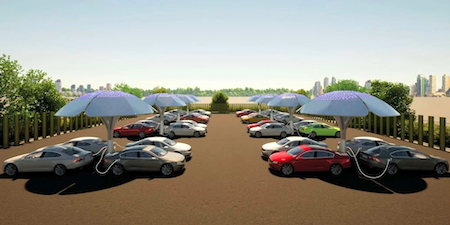Science Fiction
Dictionary
A B C D E F G H I J K L M N O P Q R S T U V W X Y Z
SolarBotanic Tree For Solar Energy - Would You Need A Forest, Or Just One?

The SolarBotanic Tree features 3-D leaf-shaped photovoltaic nanotechnology, thin-film solar cells and has a power generation capacity of 5 kilowatts.
SolarBotanic Trees, Ltd.)
A single tree generates enough electricity to provide the necessary energy for a three-room house. Excess energy produced can be sold back into the main grid.The Energy Tree can supplied with battery storage to power your house at night and charge your electric car. Overnight off peak power can be stored in the battery system.
Commercial parking is an ideal application for the SolarBotanic Tree to harvest and store solar energy and charge EV, with a rapid charge option. A grid connection allows cheaper off peak power to be stored.
The robust construction of the Energy Treeís components allows it to stand against the most turbulent conditions.

(SolarBotanic solar energy tree)
SolarBotanic's first-generation solar 'energy tree' will be available in early 2023, and the company asserts that it will be affordable once itís mass produced.
I've been liking this idea since I read David Brin's description (which came before any real-world examples, as far as I know) in his 1990 novel Earth. Consider the Sunshade-Photocell Collector:
Then he saw the geek - a codger this time - leaning against one of the slender stalks of a sunshade-photocell collector, looking directly at the three of them.
I like the idea of electric vehicles sheltering under a solar tree that is recharging them, but I can't help but think you'll need a much bigger "tree". A typical Tesla needs about 50 kWh for a decent charge, so a more realistic image would be one car charging per tree, all day.
Scroll down for more stories in the same category. (Story submitted 9/7/2022)
Follow this kind of news @Technovelgy.| Email | RSS | Blog It | Stumble | del.icio.us | Digg | Reddit |
Would
you like to contribute a story tip?
It's easy:
Get the URL of the story, and the related sf author, and add
it here.
Comment/Join discussion ( 0 )
Related News Stories - (" Engineering ")
Jetson ONE Air Races Begin, Can Air Polo Be Far Behind?
'If you're one of those rarities who haven't attended a rocket-polo "carnage", let me tell you it's a colorful affair.' - John Victor Peterson, 1938.
X-Control Janus-1 A Suitcase Aircraft
'You will notice that it... fits the suitcase nicely.' - E.D. Skinner, 1929.
Time Crystals Can Now Be Seen Directly
'It is as you thought when you constructed the time crystal, my master Vaylan.' - NK Heming, 1952.
China Steals Strato Airship Design From Google App Engine
'...war-balloons, or, as it would be more correct to call them, navigable aerostats.' - George Griffith, 1893.
Technovelgy (that's tech-novel-gee!) is devoted to the creative science inventions and ideas of sf authors. Look for the Invention Category that interests you, the Glossary, the Invention Timeline, or see what's New.
Science Fiction
Timeline
1600-1899
1900-1939
1940's 1950's
1960's 1970's
1980's 1990's
2000's 2010's
Current News
Jetson ONE Air Races Begin, Can Air Polo Be Far Behind?
'If you're one of those rarities who haven't attended a rocket-polo "carnage", let me tell you it's a colorful affair.'
Will Space Stations Have Large Interior Spaces Again?
'They filed clumsily into the battleroom, like children in a swimming pool for the first time, clinging to the handholds along the side.'
Mornine Sales Robot
'Robot-salesmen were everywhere, gesturing...'
Bipedal Robot Floats Gently While Walking
'a walking balloon proceeded with long strides of its aluminum legs...'
Musk Idea Of Cars Talking To Each Other Predicted 70 Years Ago
'My cars talk to one another.'
Elegant Bivouac Shelter Produces Water And Electricity
'There was nowhere on the planet where science and technology could not provide one with a comfortable home...'
X-Control Janus-1 A Suitcase Aircraft
'You will notice that it... fits the suitcase nicely.'
'AI Assistants' Are Actually Less Reliable For News
'Most men updated their PIP on New Year's Day...'
YES!! Remote Teleoperated Robots predicted by Technovelgy!
'...a misshapen, many-tentacled thing about twice the size of a man.'
Will Robots Ever Fold Landry?
Where have you gone, Mrs. Robinson?
Will AIs Give Better Results If You're Rude To Them?
'I said, "Listen up, motherf*cker.'
Cybertruck Robotic Arm F10 Drone Launch!
Drone away!
Black Fungus Blocks Radiation
'You were surrounded by Astrophage most of the time'
Liuzhi Process Now In Use In China
'He was in a high-ceilinged windowless cell with walls of glittering white porcelain.'
Reflect Orbital Offers 'Sunlight on Demand' And Light Pollution
'I don't have to tell you about the seven two-mile-diameter orbital mirrors...'
Will Robots Become Family Caregivers?
'The robant and the tiny old woman entered the control room slowly...'
